Nestled along the border of Tennessee and North Carolina lies the Great Smoky Mountains National Park. The park’s name comes from the Great Smoky Mountains, part of the Blue Ridge Mountains and the greater Appalachian Mountain range. This park attracts over 14 million visitors each year who come to appreciate the scenery and wildlife. With its bevy of waterfalls, mountains, and forests, you can see why it ranks as the most visited national park in the US.
Around 95% of the park is covered by forests, of which nearly 36% count as old-growth forests. Over 19,000 species live inside the park, including more than 200 bird species, 50 fish species, and 39 reptile species. The park contains 23 known snake species, most of which pose no threat to humans. Here are the 23 snakes inside the Great Smoky Mountains National Park!
The 23 Snakes Inside the Great Smoky Mountains National Park
Most visitors don’t realize how many snakes live inside the Great Smoky Mountains National Park. The majority of snakes in the park are secretive, fossorial snakes that live in burrows under the ground. That said, a fair number live in trees, while others spend most of their lives in water. If you encounter a snake inside the park, you shouldn’t touch it, even if you know it’s safe. 21 of the 23 species in the park pose little or no threat to humans, but even non-venomous snakes can inflict a painful bite. However, in its 100-year history, no one has died from a snake bite inside the park. The 23 snakes found inside the Great Smoky Mountains National Park include:
- Eastern worm snake – Carphophis amoenus amoenus
- Northern scarlet snake – Cemophora coccinea copei
- Northern black racer – Coluber constrictor constrictor
- Northern ring-neck snake – Diadophis punctatus edwardsii
- Corn snake – Elaphe guttata guttata
- Black rat snake – Elaphe obsoleta obsoleta
- Eastern hognose snake – Heterodon platirhinos
- Mole kingsnake – Lampropeltis calligaster rhombomaculata
- Eastern kingsnake – Lampropeltis getula getula
- Black kingsnake – Lampropeltis getula nigra
- Scarlet kingsnake – Lampropeltis triangulum ellipsoids
- Eastern milk snake – Lampropeltis triangulum triangulum
- Northern water snake – Nerodia sipedon sipedon
- Rough green snake – Opheodrys aestivus
- Northern pine snake – Pituophis melanoleucus melanoleucus
- Queen snake – Regina septemvittata
- Northern brown snake – Storeria dekayi dekayi
- Midland brown snake – Storeria dekayi wrightorum
- Northern redbelly snake – Storeria occipitomaculata occipitomaculata
- Southeastern crowned snake – Tantilla coronata
- Eastern garter snake – Thamnophis sirtalis sirtalis
- Eastern earth snake – Virginia valeriae valeriae
- Northern copperhead – Agkistrodon Contortrix mokasen
- Timber rattlesnake – Crotalus horridus
Water Snakes
Northern Water Snake
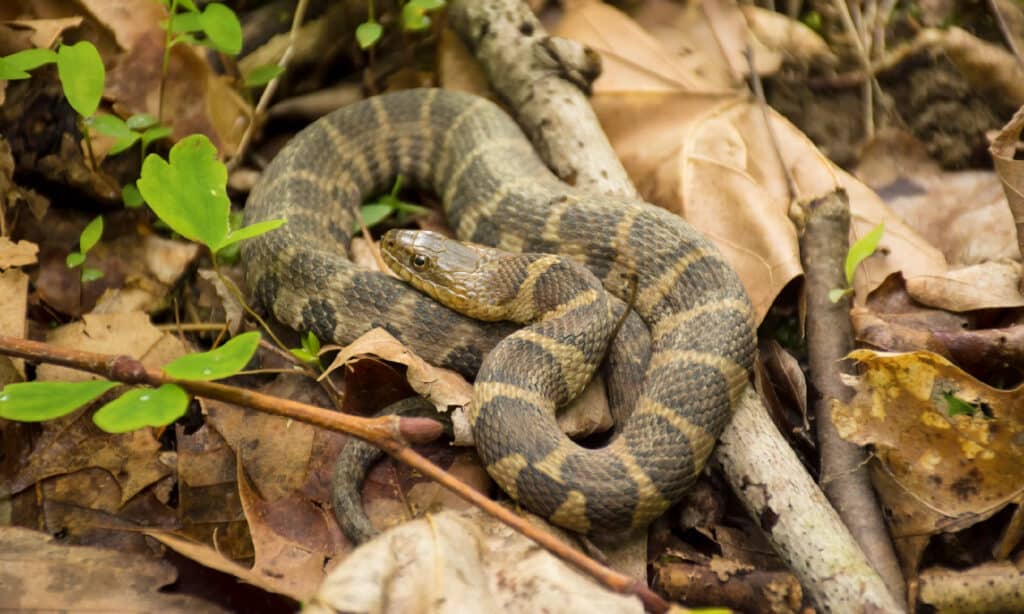
Northern water snakes will defend themselves aggressively if threatened.
©iStock.com/IcemanJ
The northern water snake goes by many names, including the common water snake, banded water snake, and black water adder. It can grow to 4 feet, 5 inches long and weigh between 2 ⅞ and 14.5 ounces. Northern water snakes can appear gray, reddish, brown, or brownish-black with dark crossbands. People sometimes mistake them for cottonmouth snakes due to their similar appearance. They are active during the day and at night. When not hunting for fish, frogs, worms, and crayfish, you can find them sunning on stream banks. Northern water snakes will defend themselves aggressively if threatened and can inflict a painful bite. That said, their bite poses no significant danger to humans.
Queen Snake

Queen snakes have excellent camouflage.
©Jason Patrick Ross/Shutterstock.com
Also known as the diamond-back water snake, moon snake, or striped water snake, the queen snake is another aquatic snake found in the Great Smoky Mountains National Park. Queen snakes always live near clear freshwater streams and waterways with rocky bottoms. In terms of appearance, queen snakes closely resemble garter snakes. Most specimens look olive, gray, or dark brown and feature yellowish-peach stripes. They rarely grow longer than 24 inches long, with females typically measuring larger than males. Their chin and head have thick scales which help protect them when pursuing prey under rocks. The bulk of their diet consists of crayfish, although they also eat frogs, newts, snails, and small fish.
Venomous Snakes
Northern Copperhead
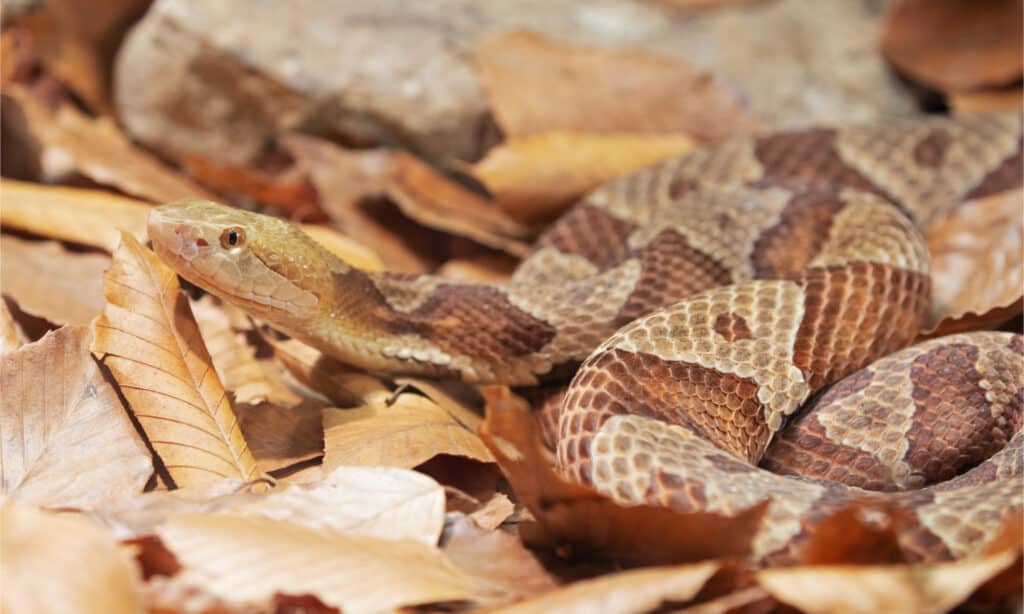
Northern copperheads are venomous snakes.
©DnDavis/Shutterstock.com
The northern copperhead is a venomous pit viper found in the eastern United States. While once identified as a subspecies of the eastern copperhead, recent taxonomic evidence suggests that the two are the same species. Most northern copperheads measure 24 to 36 inches long but can grow up to 53 inches. They feature a light brown hourglass pattern down the entire length of the body. The rest of the head and body look copper red with black banding. Northern copperheads tend to lay motionless most of the time and usually move pretty slowly. When agitated, they can strike quickly and will vibrate their tails in a threatening manner. They possess hemotoxic venom, which can damage skin tissue. Bites rarely pose a danger to adults but can prove fatal to children, the elderly, or the immunocompromised.
Timber Rattlesnake
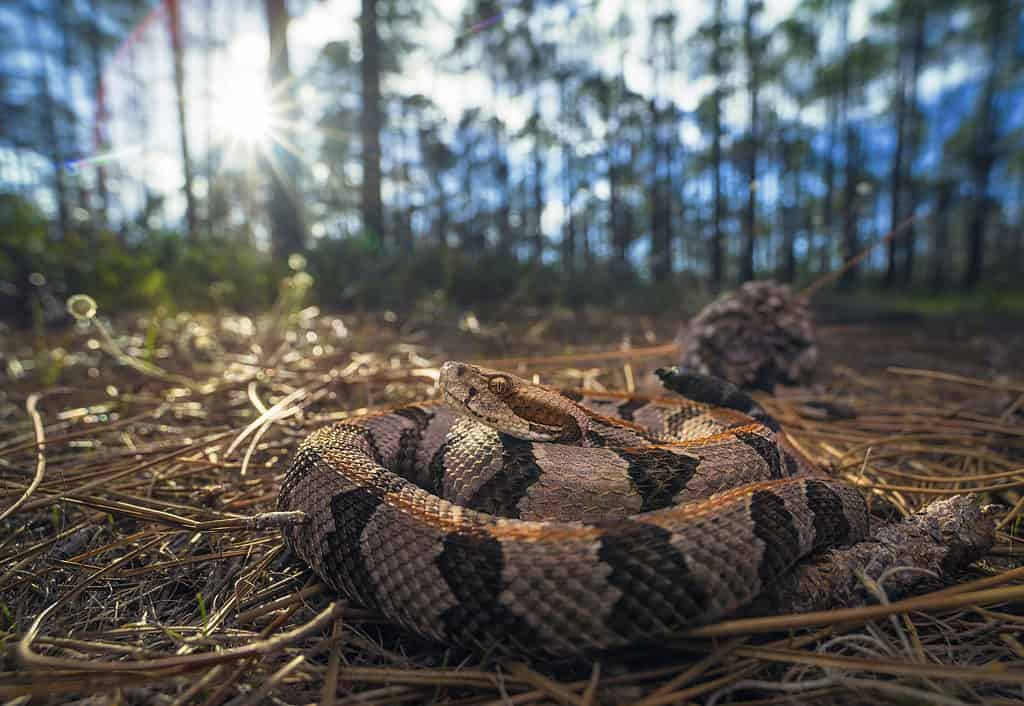
Timber rattlesnakes prefer to live in dense deciduous forests.
©Kristian Bell/Shutterstock.com
The timber rattlesnake also goes by the name canebrake rattlesnake or banded rattlesnake. It represents the only rattlesnake species found in the northeastern United States. Adult timber rattlesnakes typically measure 36 and 60 inches long and weigh 1.1 to 3.3 pounds. That said, the longest recorded specimen measured 74.5 inches, while the heaviest weighed 9.9 pounds. On the dorsal side, they feature dark brown or black crossbands on a yellowish-brown or gray background. Meanwhile, the ventral side appears yellowish and sometimes sports black marks. Timber rattlesnakes prefer to live in dense deciduous forests and often bask in the sun on rocky ledges. They use ambush tactics when hunting their prey and feed mainly on small mammals, birds, frogs, and other snakes. Timber rattlesnakes possess potent neurotoxic venom, making them among the most dangerous snakes in the United States.
Most Unusual-Looking Snake
Eastern Hognose Snake
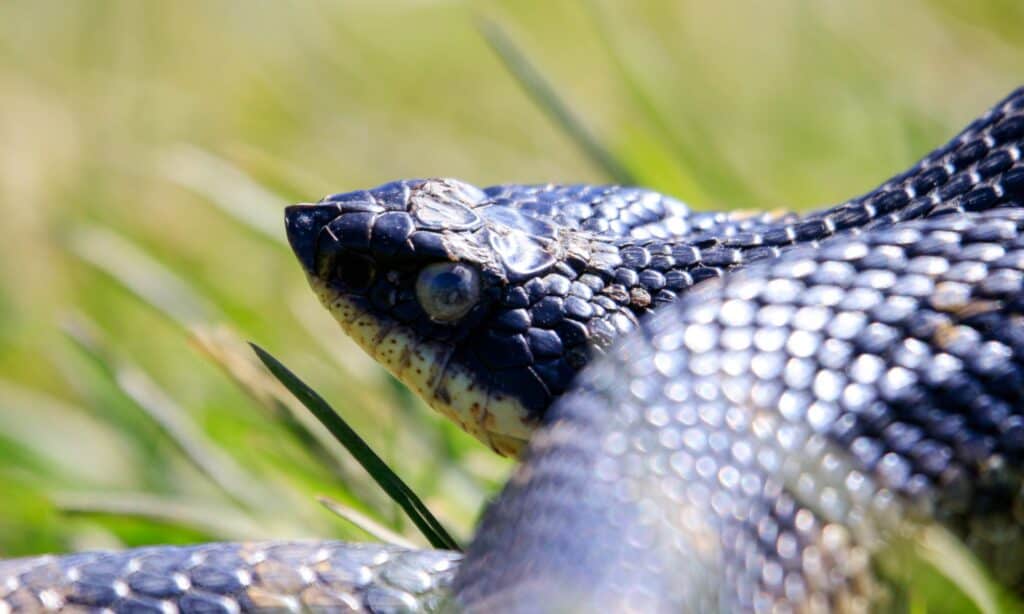
Eastern hognose snakes possess an upturned snout for digging the soil.
©iStock.com/mynewturtle
The eastern hognose snake, or spreading adder, is one of the strangest-looking snakes in the park. You can find this unusual rear-fanged snake in loose soil that makes the perfect habitat for its nests and burrows. Most eastern hognose snakes measure 28 inches long, but they can grow up to 46 inches. They vary wildly in appearance and can look red, orange, brown, green, gray, or black and feature various patterns. The one thing they all possess in common is an upturned snout that they use to dig in the soil. This upturned snout gives the snake its name, as it looks similar to a pig’s nose. Although they are not dangerous to humans, they possess mild venom designed to subdue amphibians. They contain large teeth near the back of the upper jaw, hence the term “rear-fanged snake.”
Most Colorful Snakes
Northern Scarlet Snake
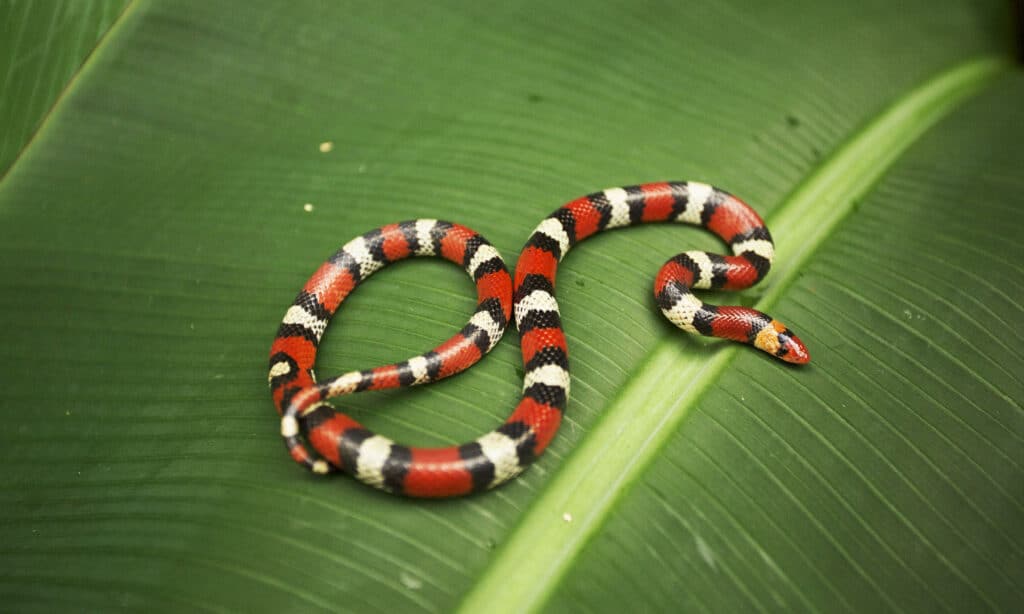
Northern scarlet snakes live in open forested areas with soft soil suitable for their burrows.
©Fine Art Photos/Shutterstock.com
The northern scarlet snake gets its specific name from the famous American zoologist Edward Drinker Cope. Most specimens measure 14 to 20 inches long. The body appears either gray or white and features 17 to 24 black-banded red blotches. People often mistake the northern scarlet snake for the similar-looking scarlet kingsnake or eastern milk snake. Northern scarlet snakes live in open forested areas with soft soil suitable for their burrows. When not hiding, northern scarlet snakes hunt for small lizards and rodents. While fairly common throughout the eastern United States, they are listed as an endangered species in Indiana and Florida.
Corn Snake
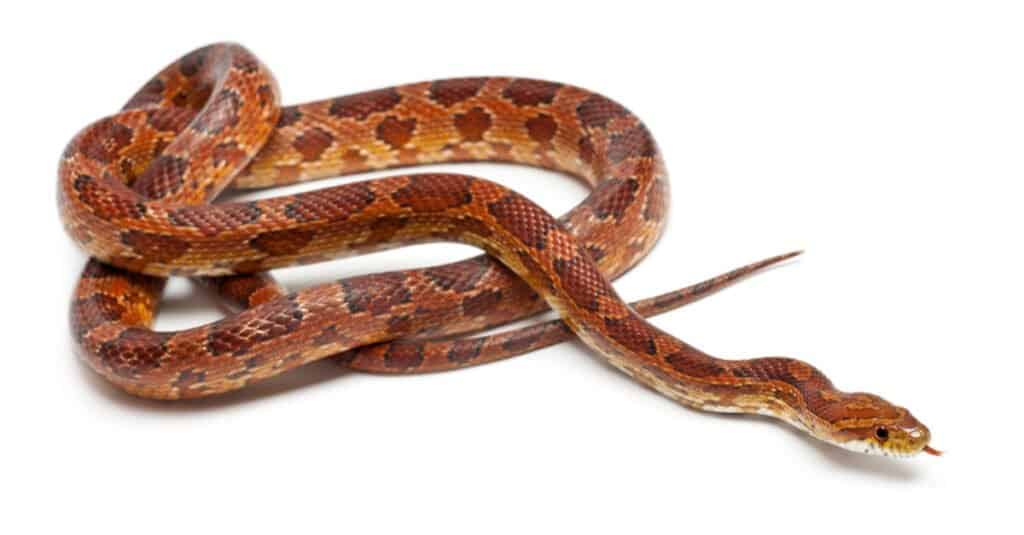
Corn snakes actually benefit humans because they prey on rodents that damage crops.
©Eric Isselee/Shutterstock.com
The corn snake is a species of rat snake found in the central and southeastern United States. People often kill them because they superficially resemble venomous copperhead snakes. This mistake can prove costly, as corn snakes actually benefit humans because they prey on rodents that damage crops. You can tell them apart from copperheads because corn snakes possess brighter scales and more slender bodies. Adult corn snakes range between 2 and 5.97 feet long. They sport black-banded red blotches on the dorsal side on a light-yellow body. Meanwhile, the ventral side features a distinctive checker pattern. Most wild corn snakes live 10 to 15 years, but the oldest captive specimen lived 32 years and 3 months.
Scarlet Kingsnake

Scarlet kingsnakes feature a repeating pattern of black-banded red and white bands down the length of their bodies.
©iStock.com/JasonOndreicka
The scarlet kingsnake also goes by the name the scarlet milk snake. Until recently, experts classified them as milk snakes, but taxonomic evidence determined that they are distinct species. Most scarlet kingsnakes measure 16 to 20 inches long, but they can grow up to 30 inches. They feature a repeating pattern of black-banded red and white bands down the length of their bodies. Scarlet kingsnakes are nocturnal, fossorial snakes, so you’ll rarely encounter one in the park. Their diet consists primarily of small snakes and lizards such as skinks. Films often use the scarlet kingsnake as a substitute for the venomous eastern coral snake due to its similar appearance. Thanks to its red snout, you can tell it apart from the black-snouted eastern coral snake.
Eastern Milk Snake
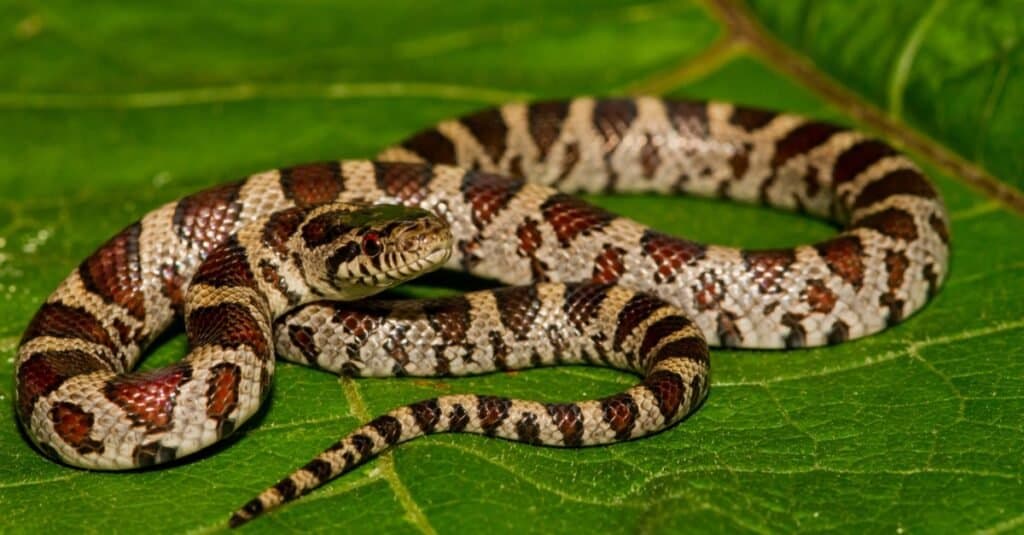
People often keep eastern milk snakes as pets due to their docile nature.
©Jay Ondreicka/Shutterstock.com
The eastern milk snake goes by many other names, including the chain snake, checkered adder, and cow-sucker. On average, eastern milk snakes measure 24 to 36 inches but can reach 52 inches long. The dorsal side sports black-blanded brown or reddish-brown markings. Meanwhile, the ventral side features black and white irregular checkmarks. People often keep eastern milk snakes as pets due to their docile nature. Although they rarely bite, they can act aggressively when cornered.
Conclusion
You can find many other common snakes inside the Great Smoky Mountains National Park. These include common snakes like garter snakes, kingsnakes, and earth snakes. All the snakes in the park form an important part of the area’s ecology and help to maintain a healthy ecosystem. Keep an eye out for any of the snakes above the next time you visit the Great Smoky Mountains National Park!
The photo featured at the top of this post is © Dennis Riabchenko/Shutterstock.com
Discover the "Monster" Snake 5X Bigger than an Anaconda
Every day A-Z Animals sends out some of the most incredible facts in the world from our free newsletter. Want to discover the 10 most beautiful snakes in the world, a "snake island" where you're never more than 3 feet from danger, or a "monster" snake 5X larger than an anaconda? Then sign up right now and you'll start receiving our daily newsletter absolutely free.
Thank you for reading! Have some feedback for us? Contact the AZ Animals editorial team.






